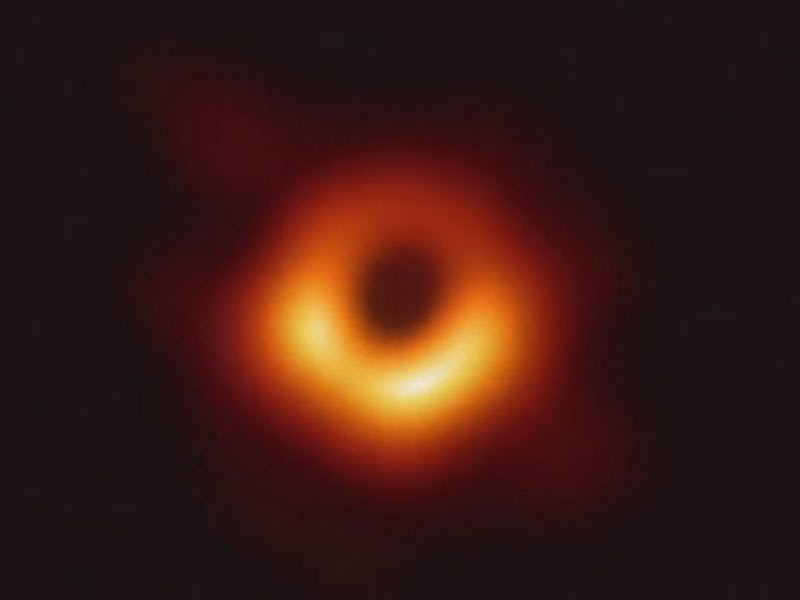The first black hole ever imaged now appears to be a little wobbly
Turns out it has been wobbling away for years.

In 2019, we got our first good glimpse of the most mysterious cosmic object we know of.
For the first time, astronomers imaged a black hole, lurking on the dark side of the universe some 53 million lightyears away at the center of the galaxy Messier 87 (M87).
The image galvanized scientists' understanding of these massive objects, and the data collected continues to feed their ever-expanding knowledge of black holes. Now, astronomers poring over these data have discovered something unexpected about this black hole — the crescent shadow that surrounds M87* appears to be wobbling. In fact, it seems to be moving so much that it has rotated over the past 10 years.
The new findings are detailed in a study published Wednesday in The Astrophysical Journal.
This graph shows the changes in the appearance of the black hole over the years.
The image of M87*, the first to be captured of a black hole ever, was compiled using the Event Horizon Telescope (EHT), which collected a massive amount of data on M87* through radio antennas around the world. The resulting picture revealed a crescent of hot gas and debris orbiting the black hole's event horizon, the region of space directly surrounding a black hole from which nothing can escape.
"In 2019, we saw the shadow of a black hole for the first time, but we only saw images observed during a one-week window, which is too short to see a lot of changes," Maciek Wielgus, an astronomer at Harvard-Smithsonian Center for Astrophysics, Black Hole Initiative Fellow, and lead author of the new study, said in a statement. "EHT can detect changes in the M87 morphology on timescales as short as a few days, but its general geometry should be constant on long timescales."
You can watch M87*'s wobble in action here:
Watch M87*'s accretion disc wibble and wobble over time.
By combining data collected from 2009 to 2013 with the data leading up to the image taken in 2019, the team of researchers behind the new study reveal that the shadow crescent around the black hole was wobbling due to the turbulence created by matter falling into the black hole.
Caught in the act — Black holes grow gradually by absorbing matter from their surroundings. They form an accretion disk of matter around them, which is usually what scientists spot in their observations of these massive, dark creatures.
As gas and other matter falls into the black hole, it heats up to billions of degrees and ionizes, generating turbulence. That is what causes the appearance of the black hole to change over time. Essentially, it is as if astronomers have captured M87* mid meal.
"Because the flow of matter falling onto a black hole is turbulent, we can see that the ring wobbles with time," Wielgus said.
M87*, captured in all its glory in 2019.
Despite the activity, the shape of the black hole's shadow itself, as well as its diameter, has remained consistent throughout the years, which is what Einstein's Theory of General Relativity had predicted of a black hole of M87*'s size (6.5 billion times the mass of the Sun).
But the new observations suggest the surrounding crescent ring does vary over time, at a rate which previous models had not predicted before, according to the researchers.
The wobbling is good news for scientists, as it may allow them to probe the black hole's accretion disc to an unprecedented level.
"The accretion flow contains matter than gets close enough to the black hole to allow us to observe the effects of strong gravity, and in some circumstances, allows us to test predictions from general relativity, like we’ve done in this study," Wielgus said.
As astronomers continue to analyze a decade's worth of observations taken of M87*, the data will not only allow them to understand this particular black hole better, but also give them valuable insights about the behavior of these behemoths across the vast universe.
Abstract: The Event Horizon Telescope (EHT) has recently delivered the first resolved images of M87*, the supermassive black hole in the center of the M87 galaxy. These images were produced using 230 GHz observations performed in 2017 April. Additional observations are required to investigate the persistence of the primary image feature—a ring with azimuthal brightness asymmetry—and to quantify the image variability on event horizon scales. To address this need, we analyze M87* data collected with prototype EHT arrays in 2009, 2011, 2012, and 2013. While these observations do not contain enough information to produce images, they are sufficient to constrain simple geometric models. We develop a modeling approach based on the framework utilized for the 2017 EHT data analysis and validate our procedures using synthetic data. Applying the same approach to the observational data sets, we find the M87* morphology in 2009–2017 to be consistent with a persistent asymmetric ring of ~40 μas diameter. The position angle of the peak intensity varies in time. In particular, we find a significant difference between the position angle measured in 2013 and 2017. These variations are in broad agreement with predictions of a subset of general relativistic magnetohydrodynamic simulations. We show that quantifying the variability across multiple observational epochs has the potential to constrain the physical properties of the source, such as the accretion state or the black hole spin.
This article was originally published on